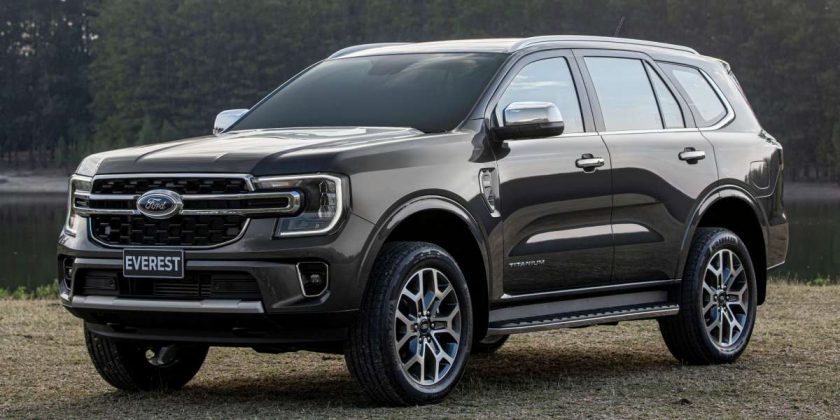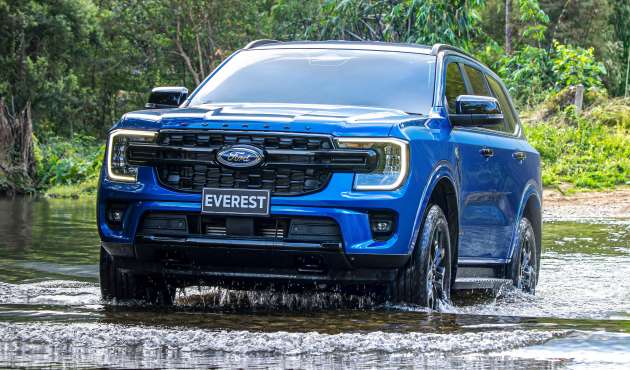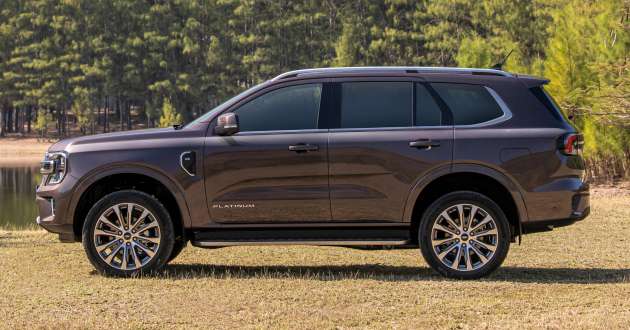A week after introducing its second-generation Raptor pick-up, Ford has unveiled its all-new Everest. When it finally goes on sale, the third-gen SUV will be available in three grades, these being Sport, Titanium+ and a new flagship trim called Platinum, with a range of different variants and models based on them.
As revealed in a teaser earlier this month, the new seven-seater features Maverick-style C-clamp headlamps like on the Raptor, but with a more conventional looking grille, complete with a traditional Ford emblem. The front end also has a mix of horizontal and vertical elements, keeping in line to the bold and rugged exterior styling. The sides feature a strong shoulder line, and a wider track results in a more dramatic swell over the wheels, enhancing the SUV’s presence.
Four engines will be available for the SUV at point of launch, three of them being diesels. The oil burners are led by a 3.0 litre twin-turbo EcoBoost V6 petrol engine, which is also found on the Raptor. Ford didn’t reveal the output numbers for the unit on the Everest, but the European Raptor’s 288 PS and 491 Nm provide a decent indication of a ballpark figure.
The other two diesel units are the familiar Single-Turbo and the Bi-Turbo 2.0 inline four-cylinder diesels, while the sole petrol mill is a 2.3L EcoBoost. The latter will be available for the Everest in select markets from 2023. As for partnering transmissions, the SUV will feature either a six-speed automatic or Ford’s 10R80 10-speed SelectShift automatic.
The wheelbase has been extended on the new Everest, and a 50 mm increase in the track helps deliver a more controlled ride on-road, while tweaks to damper settings offer better control to the Everest’s ride, both on- and off-road.
Buyers will have two 4WD systems to choose from, a two-speed electronic shift-on-the-fly transfer case, also known as a part-time 4WD system, as well as an advanced, permanent four-wheel drive system that uses an electronically controlled on-demand two-speed electromechanical transfer case (EMTC) with selectable drive modes. The Everest will also be available with two-wheel drive for some markets.
With just a press of a single button, the driver can view their driveline and diff-lock indicators, steering angle and guides, and vehicle roll and pitch angles via a dedicated off-road screen. A front camera provides a view of the terrain ahead, with predictive overlay guidelines designed to help the driver negotiate obstacles.
Despite its SUV leanings, technical ability remains high – the Everest has a water wading ability up to 800 mm and a maximum braked trailer towing capability of up to 3,500 kg. For the latter, a dedicated tow/haul drive mode has been tuned to optimise gear shift timing to maintain the best power delivery and engine braking when carrying loads, either in a trailer or in the cargo area.
New integrated or stand-off roof rails allow the Everest to now support static loads of up to 350 kg and dynamic loads of up to 100 kg on the roof, allowing the SUV to carry bikes, canoes, cargo pod or roof-top tent.
Inside, new levels of plush are to be found. Ford says that plenty of thought has been put into the function and feel of the interior, taking inspiration from modern homes and introducing improved materials and premium finishes as well as ambient lighting to the cabin. Attention has also been paid to making the interior quieter than before.
In addition to a more refined and comfortable interior, the Everest also gets a high level of digitalisation, led by a large, high-resolution portrait central touchscreen, which is available in 10.1- or 12-inch sizes. The instrument clusters are also digital, in 8- or 12.4-inch sizes depending on model and trim. In terms of infotainment, the Everest is equipped with Sync 4 system, which comes customer-ready with its voice-activated communications, entertainment and information systems.
High-series models are equipped with integrated wireless charging, a new leather-trimmed e-Shifter and an electric parking brake. Depending on the variant, heated and ventilated 10-way power adjustable memory function seats are available for the driver and eight-way for the passenger.
Speaking of seats, the second-row slides with a 60:40 split seatback, and the 50:50 split third row in the seven-seater configuration can be folded at the touch of a button on higher specification models. The automaker says that access to the third-row seats is much easier thanks to second-row seats that slide further forward than before, and both the second- and third-row seats have been designed to fold flat. Additionally, there is more storage area for occupants, and power outlets in all three rows will allow charging of devices for all.
As for safety, the Everest gets a new far-side airbag, which is positioned between the driver and front passenger to provide additional protection in the event of a side impact. This, along with dual knee airbags, brings the number of airbags up to nine, including front driver and passenger, dual seat side thorax airbags and dual side curtain airbags, which cover all three rows.
Source: Read Full Article








